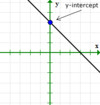2D Geometry Flashcards
What does “gradient” describe in normal English words?
It describes how steep or slanty a line is.
What is a “coordinate” or “coordinate pair”?
It’s two numbers inside brackets that tell you where a point is.
(x, y)
The first value tells you how far left/right it is from the origin. The second value tells you how far up/down it is from the origin.
What does “y-coordinate” mean?
It’s the second value in a coordinate (x,y).
What does “x-coordinate” mean?
It’s the first value in a coordinate (x,y).
How can we use the gradient to see that two lines are perpendicular?
The gradients of perpendicular lines are the negative reciprocal. For example,

What does “x-intercept” mean?
Where the line crosses the x-axis.

What does y-intercept mean?
Where the line crosses the y-axis.

What is an independent variable?
It’s the variable that influences another.
For example, the grade you get on a test depends on how much you study. Therefore, the amount you study is an independent variable.
What is a dependent variable?
It’s the variable that depends on the other.
For example, the grade you get on a test depends on how much you study. Therefore, your grade is a dependent variable.
On which axis do we put the independent variable?
The horizontal axis. (The x-axis.)
What does “linear” mean when graphing?
It makes a straight line.
What does an equation of a line do? For example, y=x+3?
It tells you about the relationship of x and y. There are infinite x and y points that make a line. This means that for any x you choose, you can use the equation to find what the y must be in order for the point to be on the line.
What is “gradient-intercept” form for a line?
y=mx+c
In the equation y=mx+c, which letter represents the y-intercept?
(Be careful to notice the sign in front of c. This is also part of the y-intercept.)

In the equation y=mx+c, which letter represents the gradient?
(Be very careful not to include “x”. This is only the number BEFORE the x. There is no x in the gradient; it’s just a number.)

What are the two methods to graph the equation Ax+By=C?
- Use algebra to rearrange the formula into gradient-intercept form (y=mx+c).
- Find the intercepts and connect the dots.
- Find the x-intercept by pluggin in y=0 and solving for x.
- Find the y-intercept by plugging in x=0 and solving for y.
What is the equation of a vertical line?
x = ________.

What is the equation of a flat horizontal line?
f(x) = ___________
y = __________

What is the gradient of a flat horizontal line?
0
(Because we go zero steps up, and 0 ÷ anything=0.)

How can we use the gradient to see that two lines are parallel?
Parallel lines have the same gradient.
How do you calculate the gradient?

How do you graph a line of the form y=mx+c?
- Mark the y-intercept (which is c from the equation) on the y-axis.
- Use the gradient (which is m from the equation) to count over to the next point.
- Count up/down
- Count over to the right
How do you find the equation of a line perpendicular to another line?
For example,

- Identify the gradient of the original line. The gradient of the new line is the negative reciprocal of this.
- Find a point that goes on the line (this is usually given).
- Plug the point (x,y) and gradient, m, into the equation y=mx+c and solve for c.
- Write y=mx+c, where m is the slope and c is the y-intercept.
How do you find the equation of a line parallel to another line?
For example, y = 2x + 8?
- Find the gradient of the original line. This is also the gradient of the new line.
- Find a point that goes on the line (this is usually given).
- Plug the point (x,y) and gradient, m, into the equation y=mx+c and solve for c.
- Write y=mx+c, where m is the slope and c is the y-intercept.
How do you find the equation of a line?
- Find the gradient.
- Find a point that goes on the line (this is usually given).
- Plug the point (x,y) and gradient, m, into the equation y=mx+c and solve for c.
- Write y=mx+c, where m is the slope and c is the y-intercept.
How do you find the equation of a line by looking at the graph?
- Look at the graph to find the y-intercept.
- Find a second point that goes through a perfect coordinate.
- Find the slope by count how far up/down and how far right you go from the left point to the right point.
- Write y=mx+c, where m is the slope and c is the y-intercept.

Plug the point (8,y) into your line equation and solve for y.

How do you rearrange a line equation into the form

- Multiply EVERYTHING by the biggest denominator.
- Move all terms to one side.

How do you find the distance bewteen 2 points?
For example, (0,4) and (8,0)
Either create a right-angled triangle on the graph and use the pythagorean theorem or use the distance formula in the booklet.

How do you find a variable, given the midpoint of two coordinates?

For each coordinate separately, you plug the points into the midpoint formula and solve.

How do you find the midpoint of two coordinates?

You plug the points into the midpoint formula from the formula booklet. (Calculate each coordinate one at a time.)



